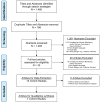Delirium Monitoring in Neurocritically Ill Patients: A Systematic Review
- PMID: 30142098
- PMCID: PMC6185789
- DOI: 10.1097/CCM.0000000000003349
Delirium Monitoring in Neurocritically Ill Patients: A Systematic Review
Abstract
Objectives: The Society of Critical Care Medicine recommends routine delirium monitoring, based on data in critically ill patients without primary neurologic injury. We sought to answer whether there are valid and reliable tools to monitor delirium in neurocritically ill patients and whether delirium is associated with relevant clinical outcomes (e.g., survival, length of stay, functional independence, cognition) in this population.
Data sources: We systematically reviewed Cumulative Index to Nursing and Allied Health Literature, Web of Science, and PubMed.
Study selection and data extraction: Inclusion criteria allowed any study design investigating delirium monitoring in neurocritically ill patients (e.g., neurotrauma, ischemic, and/or hemorrhagic stroke) of any age. We extracted data relevant to delirium tool sensitivity, specificity, negative predictive value, positive predictive value, interrater reliability, and associated clinical outcomes.
Data synthesis: Among seven prospective cohort studies and a total of 1,173 patients, delirium was assessed in neurocritically patients using validated delirium tools after considering primary neurologic diagnoses and associated complications, finding a pooled prevalence rate of 12-43%. When able to compare against a common reference standard, Diagnostic and Statistical Manual of Mental Disorders, Fourth Edition, the test characteristics showed a sensitivity of 62-76%, specificity of 74-98%, positive predictive value of 63-91%, negative predictive value of 70-94%, and reliability kappa of 0.64-0.94. Among four studies reporting multivariable analyses, delirium in neurocritically patients was associated with increased hospital length of stay (n = 3) and ICU length of stay (n = 1), as well as worse functional independence (n = 1) and cognition (n = 2), but not survival.
Conclusions: These data from studies of neurocritically ill patients demonstrate that patients with primary neurologic diagnoses can meet diagnostic criteria for delirium and that delirious features may predict relevant untoward clinical outcomes. There is a need for ongoing investigations regarding delirium in these complicated neurocritically ill patients.
Figures
Comment in
-
In the Middle of Difficulty Lies Opportunity.-Albert Einstein.Crit Care Med. 2018 Nov;46(11):1881-1882. doi: 10.1097/CCM.0000000000003399. Crit Care Med. 2018. PMID: 30312237 No abstract available.
References
-
- Mehta S, Cook D, Devlin JW, et al. Prevalence, Risk Factors, and Outcomes of Delirium in Mechanically Ventilated Adults. Critical Care Medicine. 2015;43(3):557–566. - PubMed
-
- Ely EW, Inouye SK, Bernard GR, et al. Delirium in Mechanically Ventilated Patients: Validity and Reliability of the Confusion Assessment Method for the Intensive Care Unit (CAM-ICU) JAMA. 2001;286(21):2703–2710. - PubMed
Publication types
MeSH terms
Grants and funding
LinkOut - more resources
Full Text Sources
Other Literature Sources
Medical


